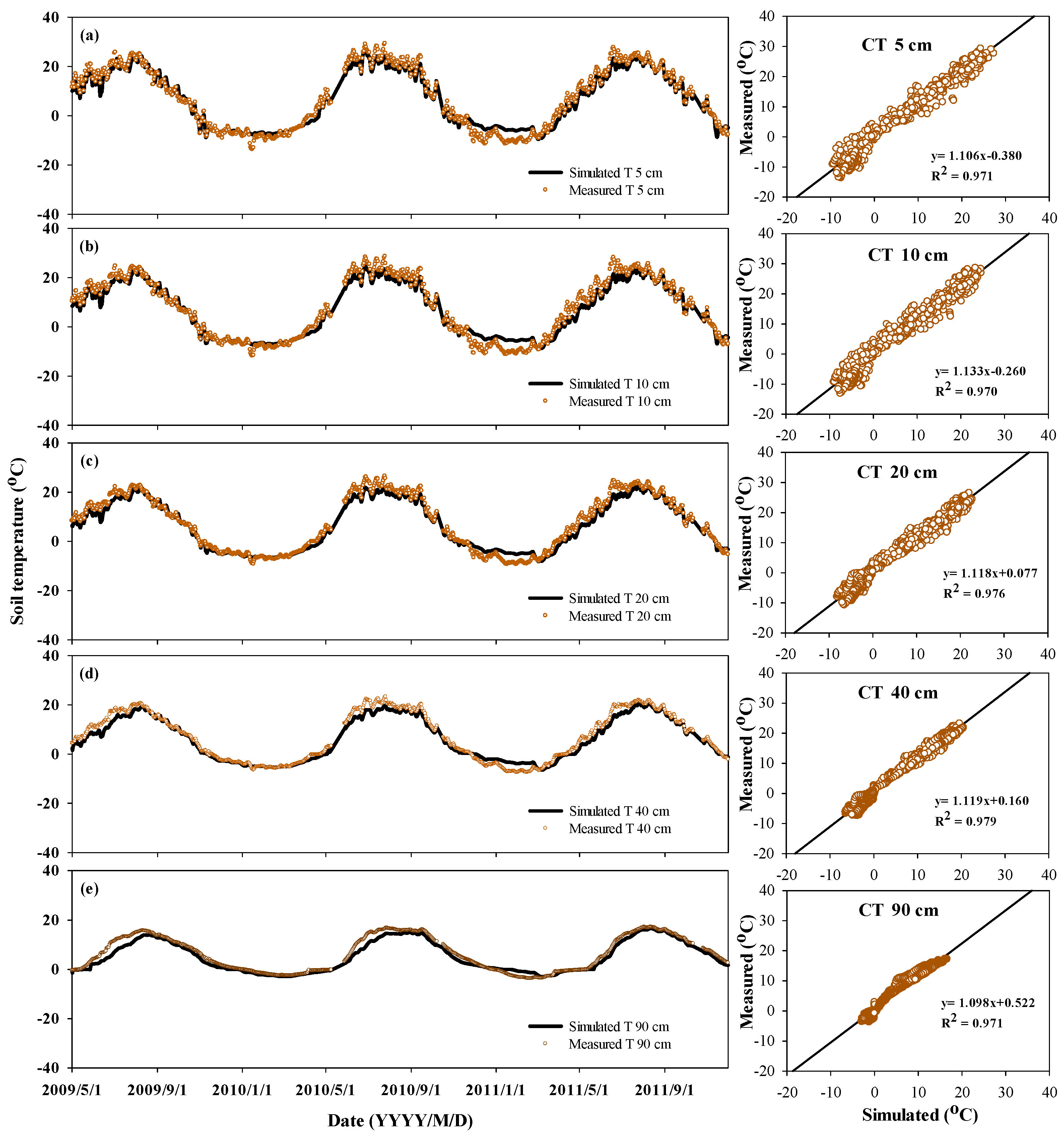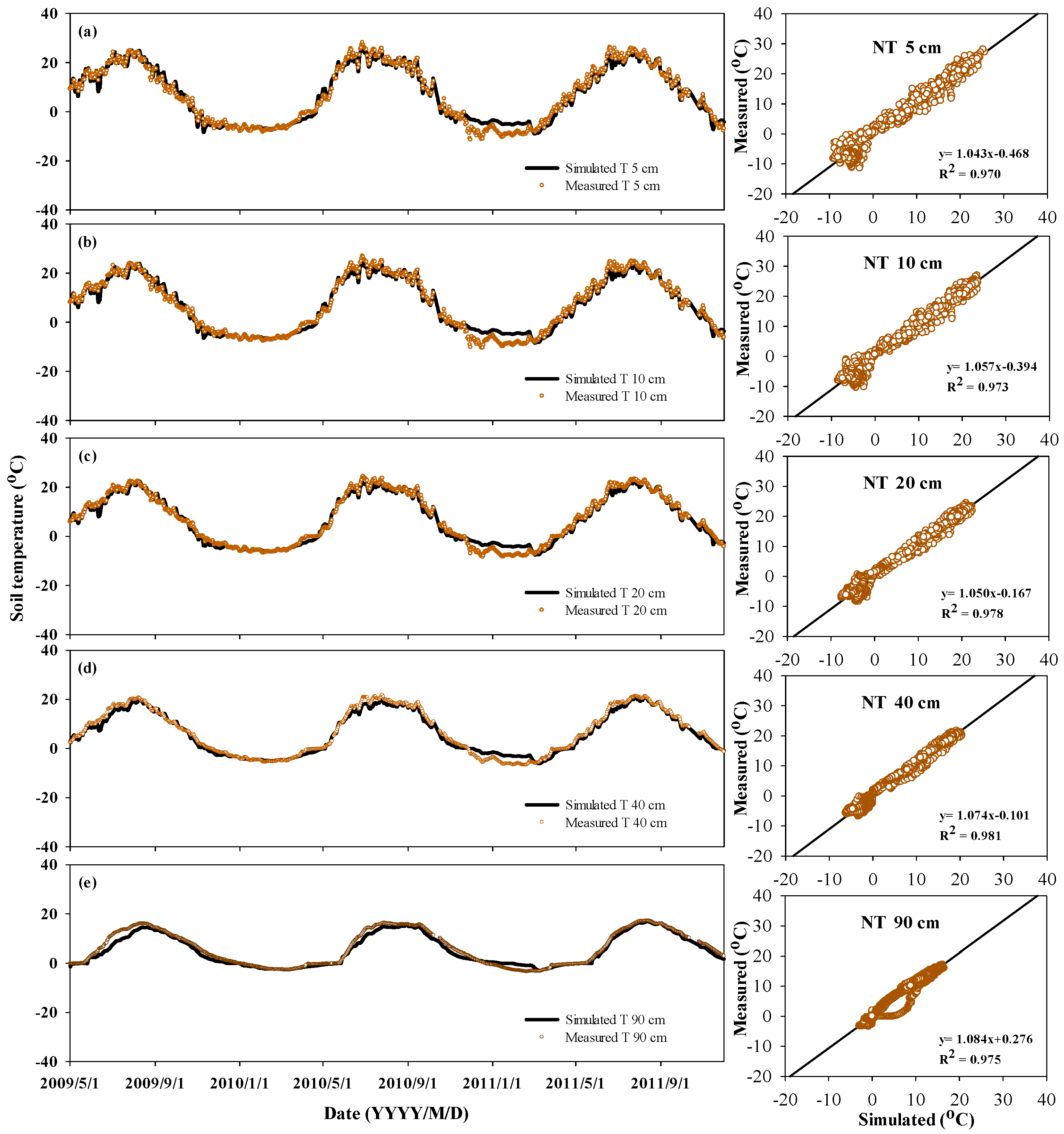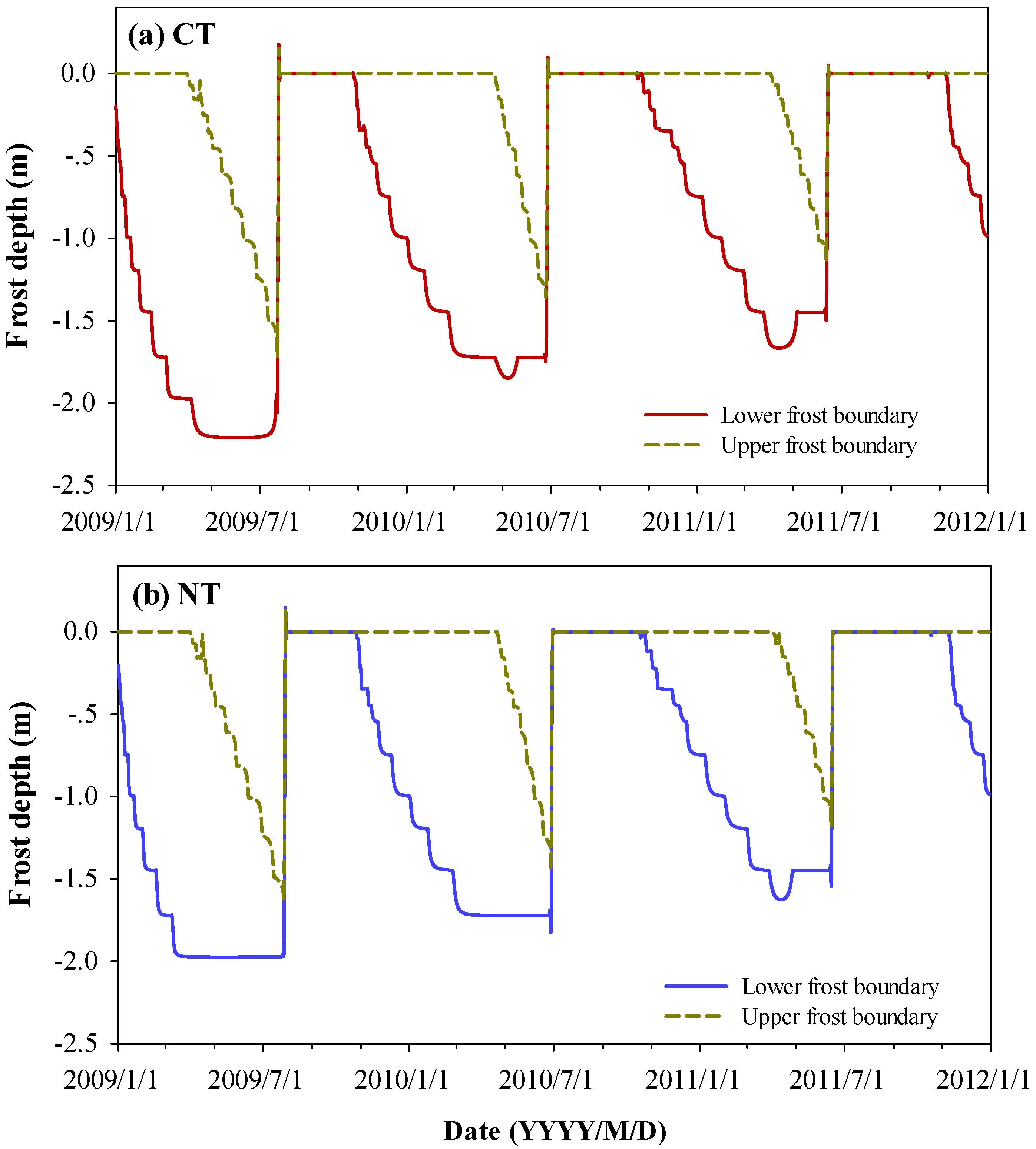Simulations of Soil Water and Heat Processes for No Tillage and Conventional Tillage Systems in Mollisols of China
Abstract
:1. Introduction
2. Material and Methods
2.1. Site Description and Experimental Design
2.2. Model Description
2.3. Model Setup
2.3.1. Meteorological Data
2.3.2. Soil Properties and Initial Input Data
2.3.3. Soil Temperature Data
2.3.4. Soil Water Data
2.4. Model Application
2.5. Evaluation of Model Outputs
3. Results and Discussion
3.1. Model Calibration and Evaluation
3.1.1. Soil Temperature
3.1.2. Soil Water Storage
3.2. Model Applying
3.2.1. Soil Surface Heat Balance
3.2.2. Root Zone Soil Water Dynamics
3.2.3. Soil Evaporation
3.2.4. Soil Frozen Depth Dynamics
3.2.5. Problem and Deficit in Calibration and Evaluation Processes
4. Conclusions
Supplementary Materials
Author Contributions
Funding
Data Availability Statement
Conflicts of Interest
References
- Liu, X.B.; Han, X.Z.; Herbert, S.J.; Xing, B. Soil organic carbon dynamics in Black soils of China under different agricultural management systems. Commun. Soil Sci. Plant. Anal. 2003, 34, 973–984. [Google Scholar] [CrossRef]
- Xu, X.Z.; Xu, Y.; Chen, S.C.; Xu, S.G.; Zhang, H.W. Soil loss and conservation in the black soil region of northeast China: A retrospective study. Environ. Sci. Policy 2010, 13, 793–800. [Google Scholar] [CrossRef]
- Wu, S.H.; Jansson, P.E.; Zhang, X.Y. Modelling temperature, moisture and surface heat balance in bare soil under seasonal frost conditions in China. Eur. J. Soil Sci. 2011, 62, 780–796. [Google Scholar] [CrossRef]
- Hassanili, A.M.; Ebrahimizadeh, M.A.; Beecham, S. The effects of irrigation methods with effluent and irrigation scheduling on water use efficiency and corn yields in an arid region. Agric. Water Manag. 2009, 96, 93–99. [Google Scholar] [CrossRef]
- Wang, Y.J.; Xie, Z.K.; Sukhdev, S.M.; Cecil, L.V.; Zhang, Y.B.; Guo, Z.H. Effects of gravel–sand mulch, plastic mulch and ridge and furrow rainfall harvesting system combinations on water use efficiency, soil temperature and watermelon yield in a semi-arid loess plateau of Northwestern China. Agric. Water Manag. 2011, 101, 88–92. [Google Scholar] [CrossRef]
- Zhang, S.L.; Zhang, X.Y.; Huffman, T.; Liu, X.B.; Yang, J.Y. Influence of topography and land management on soil nutrients variability in Northeast China. Nutr. Cycl. Agroecosyst. 2011, 89, 427–438. [Google Scholar] [CrossRef]
- Liu, X.B.; Jin, J.; Wang, G.H.; Herbert, S.J. Soybean yield physiology and development of high-yielding practices in Northeast China. Field Crops Res. 2008, 105, 157–171. [Google Scholar] [CrossRef]
- Chen, Y.; Liu, S.; Li, H.; Li, X.F.; Song, C.Y.; Cruse, R.M.; Zhang, X.Y. Effects of conservation tillage on corn and soybean yield in the humid continental climate region of Northeast China. Soil Tillage Res. 2011, 116, 56–61. [Google Scholar] [CrossRef]
- Puustinen, M.; Koskiaho, J.; Peltonen, K. Influence of cultivation methods on suspended solids and phosphorus concentrations in surface runoff on clayey sloped fields in boreal climate. Agric. Ecosyst. Environ. 2005, 105, 565–579. [Google Scholar] [CrossRef]
- Schwartz, R.C.; Baumhardt, R.L.; Evett, S.R. Tillage effects on soil water redistribution and bare soil evaporation throughout a season. Soil Tillage Res. 2010, 110, 221–229. [Google Scholar] [CrossRef]
- Campbell, C.A.; Biederbeck, V.O.; Schnitzer, M.; Selles, F.; Zentner, R.P. Effect of 6 years of zero tillage and fertilizer management on changes in soil quality of an orthicbrown chernozem in Southwestern Saskatchewan. Soil Tillage Res. 1989, 14, 39–52. [Google Scholar] [CrossRef]
- Drury, C.F.; Tan, C.S.; Welacky, T.W.; Oloya, T.O.; Hamill, A.S.; Weaver, S.E. Red clover and tillage influence on soil temperature, water content, and corn emergence. Agron. J. 1999, 91, 101–108. [Google Scholar] [CrossRef]
- Khaledian, M.R.; Mailhol, J.C.; Ruelle, P.; Rosique, P. Adapting pilote model for water and yield management under direct deeding system: The case of corn and durum wheat in a Mediterranean context. Agric. Water Manag. 2009, 96, 757–770. [Google Scholar] [CrossRef] [Green Version]
- Flerchinger, G.N.; Hardegree, S.P. Modelling near-surface soil temperature and moisture for germination response predictions of post-wildfire seedbeds. J. Arid Environ. 2004, 59, 369–385. [Google Scholar] [CrossRef]
- Whisler, F.D.; Acock, B.; Baker, D.N.; Fye, R.E.; Hodges, H.F.; Lambert, J.R.; Lemmon, H.E.; McKinion, J.M.; Reddy, V.R. Crop simulation models in agronomic systems. Adv. Agron. 1986, 40, 141–208. [Google Scholar] [CrossRef]
- Bouman, B.A.M.; van Keulen, H.; van Laar, H.H.; Rabbinge, R. The ‘school of de wit’ crop growth simulation models: A pedigree and historical overview. Agric. Syst. 1996, 52, 171–198. [Google Scholar] [CrossRef]
- Brisson, N.; Gary, C.; Justes, E.; Roche, R.; Mary, B.; Ripoche, D.; Zimmer, D.; Sierra, J.; Bertuzzi, P.; Burger, P.; et al. An overview of the crop model STICS. Eur. J. Agron. 2003, 18, 309–332. [Google Scholar] [CrossRef]
- Saito, H.; Šimůnek, J. Effects of meteorological models on the solution of the surface energy balance and soil temperature variations in bare soils. J. Hydrol. 2009, 373, 545–561. [Google Scholar] [CrossRef]
- Flerchinger, G.N.; Pierson, F.B. Modeling plant canopy effects on variability of soil temperature and water. Agricult. Forest Meterol. 1991, 56, 227–246. [Google Scholar] [CrossRef]
- Flerchinger, G.N.; Sauer, T.J.; Aiken, R.A. Effects of crop residue cover and architecture on heat and water transfer at the soil surface. Geoderma 2003, 116, 217–233. [Google Scholar] [CrossRef]
- Ji, X.B.; Kang, E.S.; Zhao, W.Z.; Zhang, Z.H.; Jin, B.W. Simulation of heat and water transfer in a surface irrigated, cropped sandy soil. Agric. Water Manag. 2009, 96, 1010–1020. [Google Scholar] [CrossRef]
- Mailhol, J.C.; Olufayo, A.A.; Ruelle, P. Sorghum and sunflower evapotranspiration and yield from simulated leaf area index. Agric. Water Manag. 1997, 35, 167–182. [Google Scholar] [CrossRef]
- Jansson, P.E.; Moonb, D.S. A coupled model of water, heat and mass transfer using object orientation to improve flexibility and functionality. Environ. Modell Softw. 2001, 16, 37–46. [Google Scholar] [CrossRef]
- Zhang, S.L.; Lövdahl, L.; Grip, H.; Jansson, P.E.; Tong, Y.N. Modelling the effects of mulching and fallow cropping on water balance in the Chinese loess plateau. Soil Tillage Res. 2007, 93, 283–298. [Google Scholar] [CrossRef]
- Beven, K.J.; Binley, A. The future of distributed models: Model calibration and uncertainty prediction. Hydro. Process 1992, 6, 279–298. [Google Scholar] [CrossRef]
- Jansson, P.E.; Karlberg, L. CoupModel-coupled heat and mass transfer model for soil–plant–atmosphere system. In TRITA-LWR Report, 3087; Royal Institute of Technology, Department of Land and Water Resources Engineering: Stockholm, Sweden, 2004; p. 427. [Google Scholar]
- Wu, S.H.; Jansson, P.E.; Kolari, P. Modeling seasonal course of carbon fluxes and evapotranspiration in response to low temperature and moisture in a boreal Scots pine ecosystem. Ecol. Model. 2011, 222, 3103–3119. [Google Scholar] [CrossRef]
- Beck, H.E.; Zimmermann, N.E.; McVicar, T.R.; Vergopolan, N.; Berg, A.; Wood, E.E. Publisher Correction: Present and future Köppen-Geiger climate classification maps at 1-km resolution. Sci. Data 2020, 7, 274. [Google Scholar] [CrossRef] [PubMed]
- Jansson, P.E.; Halldin, S. Model for the annual water and energy flow in a layered soil. In Comparison of Forest and Energy Exchange Models; Halldin, S., Ed.; Society for Ecological Modelling: Copenhagen, Denmark, 1979; pp. 145–163. [Google Scholar]
- Eckersten, H.; Jansson, P.E.; Johnsson, H. SOILN Model, Version 9.2, User’s Manual. Division of Hydrotechnics; Swedish Agricultural University: Uppsala, Sweden, 1998. [Google Scholar]
- Monteith, J.L. Evaporation and environment. In The State and Movement of Water in Living Rrganisms, Proceedings of the 19 Symposium of Society of Experimental Biology, Swansea, 1964; Fogg, G.E., Ed.; The Company of Biologists: Cambridge, UK, 1965; pp. 205–234. [Google Scholar]
- Jansson, P.E. CoupModel: Model use, calibration, and validation. Trans. ASABE 2012, 55, 1335–1344. [Google Scholar] [CrossRef]
- Richards, L.A. Capillary conduction of liquids through porous media. Physics 1931, 1, 318–333. [Google Scholar] [CrossRef]
- Brooks, R.H.; Corey, A.T. Hydrological Properties of Porous Media; Hydrology Paper No. 3; Colorado State University: Fort Collins, CO, USA, 1964. [Google Scholar]
- Mualem, Y. A new model for predicting the hydraulic conductivity of unsaturated porous media. Water Resour. Res. 1976, 12, 513–522. [Google Scholar] [CrossRef] [Green Version]
- Liu, S.; Yang, J.Y.; Drury, C.F.; Liu, H.L.; Reynolds, W.D. Simulating maize (Zea mays L.) growth and yield, soil nitrogen concentration, and soil water content for a long-term cropping experiment in Ontario, Canada. Can. J. Soil Sci. 2014, 94, 435–452. [Google Scholar] [CrossRef]
- Liu, S.; Yang, J.Y.; Yang, X.M.; Drury, C.F.; Jiang, R.; Reynolds, W.D. Simulating maize yield at county scale in southern Ontario using the decision support system for agrotechnology transfer model. Can. J. Soil Sci. 2021, 101, 734–748. [Google Scholar] [CrossRef]
- Sarkar, S.; Singh, S.R. Interactive effect of tillage depth and mulch on soil temperature, productivity and water use pattern of rainfed barley (Hordium vulgare L.). Soil Tillage Res. 2007, 92, 79–86. [Google Scholar] [CrossRef]
- Soane, B.D.; Ball, B.C.; Arvidsson, J.; Basch, G.; Moreno, F.; Roger-Estrade, J. No-till in northern, western and south-western Europe: A review of problems and opportunities for crop production and the environment. Soil Tillage Res. 2012, 118, 66–87. [Google Scholar] [CrossRef] [Green Version]
- Chassot, A.; Stamp, P.; Richner, W. Root distribution and morphology of maize seedlings as affected by tillage and fertilizer placement. Plant Soil. 2001, 231, 123–135. [Google Scholar] [CrossRef]
- Sommer, R.; Wall, P.C.; Govaerts, B. Model-based assessment of maize cropping under conventional and conservation agriculture in highland Mexico. Soil Tillage Res. 2007, 94, 83–100. [Google Scholar] [CrossRef]
- Rasmussen, L.H.; Zhang, W.X.; Hollesen, J.; Cable, S.; Christiansen, H.H.; Jansson, P.E.; Elberling, B. Modelling present and future permafrost thermal regimes in Northeast Greenland. Cold Reg. Sci. Technol. 2018, 146, 199–213. [Google Scholar] [CrossRef]
- Karunatilake, U.; van Es, H.M.; Schindelbeck, R.R. Soil and maize response to plow and no-tillage after alfalfa-to-maize conversion on a clay loam soil in New York. Soil Tillage Res. 2000, 55, 31–42. [Google Scholar] [CrossRef]
- Wang, X.B.; Dai, K.; Zhang, D.C.; Zhang, X.M.; Wang, Y.; Zhao, Q.S.; Cai, D.X.; Hoogmoed, W.B.; Oenema, O. Dryland maize yields and water use efficiency in response to tillage/crop stubble and nutrient management practices in China. Field Crops Res. 2011, 120, 47–57. [Google Scholar] [CrossRef]
- Su, Z.Y.; Zhang, J.S.; Wu, W.L.; Cai, D.X.; Lv, J.J.; Jiang, G.H.; Huang, J.; Gao, J.; Hartmann, R.; Gabriels, D. Effects of conservation tillage practices on winter wheat water-use efficiency and crop yield on the loess plateau, China. Agric. Water Manag. 2007, 87, 307–314. [Google Scholar] [CrossRef]
- Alvarez, R.; Steinbach, H.S. A review of the effects of tillage systems on some soil physical properties, water content, nitrate availability and crops yield in the Argentine Pampas. Soil Tillage Res. 2009, 104, 1–15. [Google Scholar] [CrossRef]
- Sharma, P.; Abrol, V.; Sharma, R.K. Impact of tillage and mulch management on economics, energy requirement and crop performance in maize-wheat rotation in rainfed subhumid inceptisols, India. Eur. J. Agron. 2011, 34, 46–51. [Google Scholar] [CrossRef]
- Cullum, R.F. Influence of tillage on maize yield in soil with shallow fragipan. Soil Tillage Res. 2012, 119, 1–6. [Google Scholar] [CrossRef]
- Fabrizzi, K.P.; García, F.O.; Costa, J.L.; Picone, L.I. Soil water dynamics, physical properties and corn and wheat responses to minimum and no-tillage systems in the southern Pampas of Argentina. Soil Tillage Res. 2005, 81, 57–69. [Google Scholar] [CrossRef]
- Horton, R.; Bristow, K.L.; Kluitenberg, G.J.; Sauer, T.J. Crop residue effects on surface radiation and energy balance—Review. Theor. Appl. Climatol. 1996, 54, 27–37. [Google Scholar] [CrossRef] [Green Version]
- Liu, S.; Zhang, X.Y.; Kravchenko, Y.; Iqbal, M.A. Maize (Zea mays L.) yield and soil properties as affected by no tillage in the black soils of China. Acta Agric. Scand. B Soil Plant Sci. 2015, 65, 554–565. [Google Scholar] [CrossRef]
- Zhang, S.L.; Lövdahl, L.; Grip, H.; Tong, Y.N.; Yang, X.Y.; Wang, Q.J. Effects of mulching and catch cropping on soil temperature, soil moisture and wheat yield on the loess plateau of China. Soil Tillage Res. 2009, 102, 78–86. [Google Scholar] [CrossRef]








| Soil Depth | Silt | Clay | Wilting Point | Saturated Water Content | Residual Water Content | Saturated Hydraulic Conductivity | λ | Air Entry |
|---|---|---|---|---|---|---|---|---|
| (cm) | (%) | (%) | (vol %) | (vol %) | (vol % ) | (mm/day) | (cm) | |
| 0−5 | 29.3 | 40.7 | 0.12 | 0.57 | 4.40 | 2000 | 0.10 | 40.97 |
| 5−10 | 29.3 | 40.7 | 0.14 | 0.52 | 4.40 | 2000 | 0.10 | 40.97 |
| 0−5 | 29.3 | 39.9 | 0.15 | 0.62 | 4.40 | 1500 | 0.09 | 43.35 |
| 30−50 | 29.1 | 40.8 | 0.15 | 0.58 | 3.25 | 1500 | 0.12 | 36.53 |
| 50−70 | 29.1 | 40.8 | 0.14 | 0.46 | 4.48 | 1500 | 0.10 | 47.91 |
| 70−90 | 27.9 | 43.3 | 0.13 | 0.59 | 4.15 | 950 | 0.10 | 47.49 |
| 90−110 | 27.9 | 43.3 | 0.17 | 0.49 | 3.60 | 500 | 0.11 | 45.00 |
| 110−130 | 29.9 | 39.7 | 0.17 | 0.48 | 3.93 | 260 | 0.10 | 47.08 |
| 130−150 | 29.9 | 39.7 | 0.18 | 0.45 | 4.38 | 75 | 0.08 | 49.63 |
| 150−170 | 29.9 | 39.7 | 0.18 | 0.4 | 4.40 | 20 | 0.07 | 47.19 |
| 170−190 | 29.9 | 39.7 | 0.19 | 0.4 | 4.40 | 20 | 0.05 | 45.08 |
| Crop. | Planting | Harvest | Fertilization | Tillage | Soil Covers with Crop Residue | ||||
|---|---|---|---|---|---|---|---|---|---|
| Date | Date | N | P2O5 | K2O | NT | CT | NT | CT | |
| (kg ha−1) | (kg ha−1) | (kg ha−1) | % | % | |||||
| Maize | 1 May 2009 | 9 October 2009 | 160 | 52 | 15 | No−till | Till twice after 15 days seeding | 70 | 0 |
| (25 cm)chisel plowing in furrow (25 cm)−rototilling (30 cm depth) | |||||||||
| Soybean | 5 May 2010 | 25 September 2010 | 20 | 52 | 15 | No−till | Till twice after 15 days seeding | 70 | 0 |
| (25 cm)−chisel plowing in furrow (25 cm)−rototilling (30 cm depth) | |||||||||
| Maize | 5 May 2011 | 4 October 2011 | 160 | 52 | 15 | No−till | Till twice after 15 days seeding | 70 | 0 |
| (25 cm)−chisel plowing in furrow (25 cm)−rototilling (30 cm depth) | |||||||||
Publisher’s Note: MDPI stays neutral with regard to jurisdictional claims in published maps and institutional affiliations. |
© 2022 by the authors. Licensee MDPI, Basel, Switzerland. This article is an open access article distributed under the terms and conditions of the Creative Commons Attribution (CC BY) license (https://creativecommons.org/licenses/by/4.0/).
Share and Cite
Liu, S.; Li, J.; Zhang, X. Simulations of Soil Water and Heat Processes for No Tillage and Conventional Tillage Systems in Mollisols of China. Land 2022, 11, 417. https://doi.org/10.3390/land11030417
Liu S, Li J, Zhang X. Simulations of Soil Water and Heat Processes for No Tillage and Conventional Tillage Systems in Mollisols of China. Land. 2022; 11(3):417. https://doi.org/10.3390/land11030417
Chicago/Turabian StyleLiu, Shuang, Jianye Li, and Xingyi Zhang. 2022. "Simulations of Soil Water and Heat Processes for No Tillage and Conventional Tillage Systems in Mollisols of China" Land 11, no. 3: 417. https://doi.org/10.3390/land11030417






